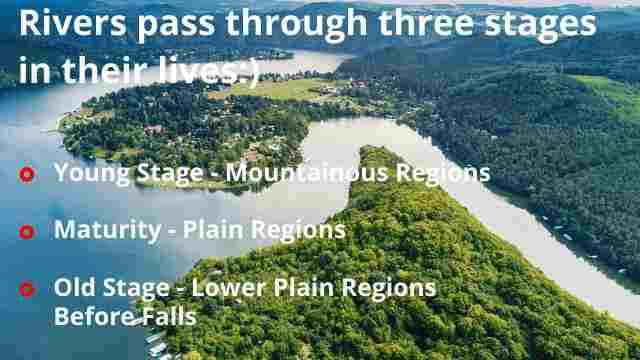Rivers are considered to be the destiny lines for the countries. The rivers of India have special importance in economic growth, as well as, rivers are even more religious for Indian because it is considered holy in Hinduism.
Apart from this India's oldest civilization Indus Valley Civilization also developed in the river valley and so many cities developed on river banks. Thus rivers play a crucial role in the country with many characteristics.
Some Important Points Related To The Rivers Of India
- Based on the origin, rivers are divided into four groups in India:
- Rivers of the Himalayan region
- Rivers of Peninsular regions
- Rivers of Aravali regions
- Rivers of intermediate plateau and hills.
- Most of the rivers in the Peninsula are rainy.
- Most of the major rivers fall into the Bay of Bengal.
- Rivers that fall into the Bay of Bengal make Deltas, while rivers that fall into the Arabian sea make estuaries.
- The catchment area of the Himalayan rivers is more than Peninsula India's rivers.
- Many rivers of the Himalaya like Sindhu, Teesta, Brahmaputra, and Satluj are Antecedent rivers in India.
- Rivers of India which originates from the Himalayas were made on great plains in northern India.
 |
| The Rivers Of India |
Major rivers of India and their origin place with tributaries river List
More than 400 small and large rivers are flown in India, in which 10 to 12 rivers and their tributaries are important for exams and other perspectives because all these rivers play a vital role in India like river valley projects, transportation, Irrigations, etc. Here you will know one by one all major rivers of India and its tributaries rivers.
The Ganga river:
The Ganga is the longest river in India. It is considered to be the Holy River of India. It is also known as the Bhagirathi river. The Ganga originates from the Gangotri of Gomukh glacier of the Greater Himalaya in Uttarakhand state.
This river flows through Uttarakhand, Uttar Pradesh, Bihar and West Bengal states of India. After a 2400 km long journey Ganga river inter in Bangladesh, where it is known as the Padma river.
Yamuna, Gomati, Ghagra, Son, Gandak, Budhi Gandak, Bagmati, Kosi, are the major tributary rivers of the Ganga in India while the Brahmaputra makes a tributary of Ganga in Bangladesh.
Before falling in the Bay of Bengal river Ganga makes a delta which is known as the Sundarbans delta. It is the world's largest delta where Mangrove forests are mostly found. Sundarbans is also a Nationa Park and Tiger reserve of India.
Yamuna River:
Originates from the Yamunotri Glacier which is situated on the west slope of Bandarpunch in Uttarakhand state.
The Yamuna merges into the Ganga river near Prayagraj (Allahabad) in Uttar Pradesh. It covers a distance of 1375 km from origin to mouth. Chambal, Ken, Betwa, Sindh are the main tributary rivers of Yamuna. Major cities Delhi, Agra, Mathura are situated on the riverbank of Yamuna.
Know: Major cities names and related river bank
Indus/Sindhu River:
Sindhu has been the birthplace of India's ancient civilization 'Indus civilization'. Sindhu river originates from Mansarovar Lake (near the north slope of Mount Kailash) in Tibet. Sanokhyababa Glacier is the main source of water in Sindhu.
It flows through three countries Tibet (China), India (Jammu and Kashmir), and Pakistan. The total length of this river is 2,880 km, in which 1,114 km passed in India. This river makes the world's deepest Gorge (Bunji Gorge 5181m) on Himalaya near Bunji in India.
Sayonk, Gilgit, Jhelum, Chenab, Ravi, Satluj are the main tributary rivers of Sindhu. Lastly, it has been flowing through the plains of Pakistan merge into the Arabian sea.
Brahmaputra River:
World's largest River Island Mazuli has been made by the Brahmaputra in the Assam state of India. The river Brahmaputra is 1280 km navigable from the Bay of Bengal to Dibrugarh (Assam). It flows through a rift valley in Arunachal Pradesh.
It originates from the Glaciers near the Mansarovar Lake of Tibetan Plateaus and falls into the Bay of Bengal. The total length of this river is 2900 km in which 916 km length crosses through India. Tista, Manas, Subansiri, Dibang, Lohit, Dhansiri, Bidhi Dibang are the Main tributary rivers of Brahmaputra.
The Brahmaputra is also known as Tsangpo in Tibet (China), when it enters Arunachal Pradesh state of India it is called Dihang, after entering Bangladesh it is known as the Jamuna river. After the merging in the Ganges (Padma) in Bangladesh, it is known as the Meghna River.
Satluj River:
It originates from the Rakshastal Lake of the Tibetan plateau. The total length of this river is 1500 km in which 1050 km flows through India.
Spiti and Vayas river are the Main tributary rivers of Satluj which merge near Sultanpur city of Punjab.
After crossing two states Himachal Pradesh and Punjab of India it enters Pakistan and lastly, the river Satluj merges into Chenab river. One of the highest dams in the world Bhakra Nangal Dam (518m. from SL) was constructed on this River in Himachal Pradesh State. It is also the second-largest river valley project in India.
Godavari River:
River Godavari originates from western ghat hills in the Nashik district of Maharashtra. It is known as the Old / Bridh Ganga. The Godavari is the longest river in Peninsular India. The total length of this river is 1465 km.
Penganga, Vardha, Wainganga, Indrawati, Sabari, and Manjira are the main tributaries of the Godavari River.
Before it falls in the Bay of Bengal it makes a Delta, which is known as the Godavari delta. These Delta regions are the second largest Mangrove forest areas of India.
Krishna River:
River Krishna originates near the Mahabaleshwar town of Maharashtra. It is the fourth largest river basin of India. The total length of this river from origin to mouth is 1401 km. It also makes a delta before falling into the Bay of Bengal. Deltas of Godavari and Krishna rivers have merged with each other in the Bay of Bengal.
Koyna, Malprabha, Ghatprabha, Panchganga, Dudhganga, Bhima, Tungabhadra, and Moosi rivers are the main tributaries of the River Krishna.
Nagarjuna Sagar Dam was constructed for irrigation across the Krishna river. Due to Nagarjuna Sagar Reservoir Telangana and Andhra Pradesh get benefits in agriculture.
See Here: Most important questions of geography
Kaveri River:
Kaveri is known as the Ganga of South India. It originates from the Brahmagiri hills of the Coorg district (Karnataka). It flows 800 km through the Karnataka and Tamilnadu states and falls into the Bay of Bengal. Hemvati, Bhavani, Noil, Amravati are the main tributary rivers of Kaveri.
Shivasamudram waterfall has been made by this river where India's first successful Hydropower plant was constructed. Shivasamudram and Srirangpatanam islands have also been made by river Kaveri in Andhra Pradesh.
Mahanadi River:
It originates from the Amarkantak hills near Sihawa of the Raipur district (Chhattisgarh). It flows 815 km through Chhattisgarh and Orissa.
Mahanadi makes deltas near Katak and falls into the Bay of Bengal. Brahmani and Baitarani rivers are tributaries of the Mahanadi river.
Hirakud dam was constructed on the Mahanadi at Sambalpur, which is the largest mainstream dam in the world.
Narmada River:
Narmada river flows East to West through a fault valley between the Vindhyan and Satpura Mountain. It originates from the Amarkantak Hills in Chhattisgarh and falls into the Arabian sea. The total length of this river from origin to mouth is 1312 km.
Narmada makes an estuary near the Bharuch (Gujrat). It also makes a waterfall in Bhedaghat (Jabalpur) which is known as Dhuandhar Waterfall. There are so many smaller rivers that make tributaries but Hiran, Barana, Dudhi, Tava, and Sher are the Main tributaries of Narmada.
Chambal River:
Due to erosion Ravines are found in the regions of Chambal. The river originates from the Junapat Hills in Madhya Pradesh and merges into the Yamuna river.
Chambal flows 995 km through Madhya Pradesh, Rajasthan, and Uttar Pradesh states.
Ken, Betwa, Banas, Kali, Sindh, Parvati rivers are tributaries of river Chambal. Under the Chambal valley project Gandhi Sagar (M.P), Rana Pratap Sagar Dam and Jawahar Sagar (Rajasthan) Dams were constructed across the Chambal river.
Chenab River:
Chenab is a tributary river of Sindhu, which originates near the Baralacha la pass and merges into the Sindhu River in Pakistan. It is known as Chandrabhaga in the Himalayan regions.
It flows 974 km through India and Pakistan. Ravi and Sutlej are the main tributaries of Chenab. Dulhasti and Salal Hydropower projects were constructed across the river Chenab in Jammu and Kashmir.
Apart from all these major rivers of India, many other rivers are flowing in India, in which Periyar (Kerala), Luni (Rajasthan), Sabarmati (Gujrat), Punoor (Karnataka), Hugli, Damodar (West Bengal), Tapti (MP), Son (Bihar), Kshipra (MP), Sharda/Kali Ganga (UP), etc are the most important rivers in India.


Post a Comment